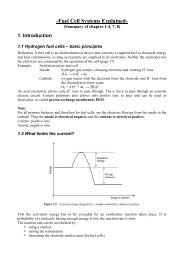Chapter 8. ORGANIC SOLAR CELLS - from and for SET students
Chapter 8. ORGANIC SOLAR CELLS - from and for SET students
Chapter 8. ORGANIC SOLAR CELLS - from and for SET students
You also want an ePaper? Increase the reach of your titles
YUMPU automatically turns print PDFs into web optimized ePapers that Google loves.
<strong>SOLAR</strong> <strong>CELLS</strong> <strong>Chapter</strong> <strong>8.</strong> Exciton solar cells<br />
this process an electron is transferred <strong>from</strong> an electron donor (D) material to an electron<br />
acceptor (A) material with the aid of the additional input energy of an absorbed photon with<br />
energy hν. An electron donor is characterized by a molecular material with a small electron<br />
affinity. Vice versa an electron acceptor is a material with a high electron affinity. The<br />
difference between both electron affinity levels is the driving <strong>for</strong>ce required <strong>for</strong> the exciton<br />
dissociation. In the photoinduced electron transfer process an exciton at the D/A interface<br />
decays by creation of the charge-separated state consisting of the radical cation of the donor<br />
(D •+ ) <strong>and</strong> the radical anion of the acceptor (A •- ).<br />
D + A + hν → D* + A (or D + A*) → D •+ + A •-<br />
For an efficient charge generation, it is essential that the charge-separated state is the<br />
thermodynamically <strong>and</strong> kinetically most favourite pathway <strong>for</strong> the exciton. There<strong>for</strong>e, it is<br />
important that the energy of the absorbed photon is used <strong>for</strong> generation of the chargeseparated<br />
state <strong>and</strong> is not lost via competitive processes like fluorescence or non-radiative<br />
decay. In addition, the charge-separated state should be stabilized, so that the photogenerated<br />
charges can migrate to one of the electrodes. There<strong>for</strong>e, the back electron transfer or<br />
recombination should be slowed down as much as possible.<br />
In a homojunction between a p-type <strong>and</strong> an n-type silicon semiconductor under<br />
illumination electrons flow <strong>from</strong> the p-type to the n-type semiconductor. In a heterojunction<br />
based on an electron donor layer D <strong>and</strong> an electron accepting layer A, under illumination<br />
electrons flow <strong>from</strong> the D to the A layer as illustrated in Figure <strong>8.</strong>4. There<strong>for</strong>e the D layer is<br />
also denoted as the p-type layer <strong>and</strong> the A layer as the n-type layer in analogy with a silicon<br />
pn junction. There<strong>for</strong>e molecular materials with a low ionisation potential are commonly ptype<br />
<strong>and</strong> materials with a high electron affinity n-type.<br />
<strong>8.</strong>4.4. Charge transport<br />
The charge transport mechanisms operating in IPV cells <strong>and</strong> organic solar cells to drive<br />
charge carriers towards the electrodes are again very different. Light absorption in IPV cells<br />
leads directly to the production of electrons <strong>and</strong> holes in the same material. Since the two<br />
carrier types have the same spatial distribution, the concentration gradient, which is the<br />
driving <strong>for</strong>ce <strong>for</strong> the transport by diffusion is identical (See Figure <strong>8.</strong>6). There<strong>for</strong>e both charge<br />
carriers are driven in the same direction. Since this is a small driving <strong>for</strong>ce in IPV cells, the<br />
electrical potential gradient present at the interface of a p-n junction (the b<strong>and</strong> bending) is able<br />
to separate the photo-induced electrons <strong>from</strong> the holes effectively. In contrast to IPV cells in<br />
organic solar cells after the charge transfer the electrons <strong>and</strong> holes are in close proximity.<br />
There<strong>for</strong>e there is a large chemical potential gradient that drives the charge carriers away<br />
<strong>from</strong> the exciton dissociating interface.<br />
-<strong>8.</strong>8-






